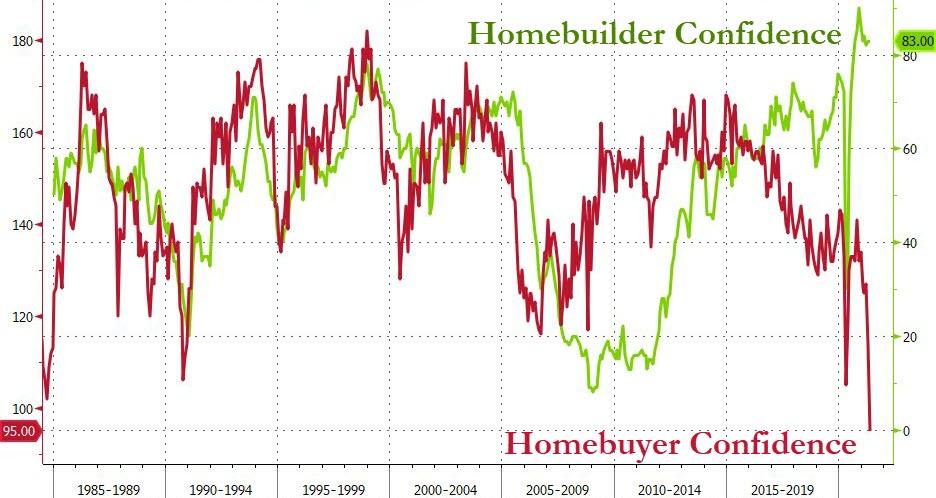
Stocks traded flat this morning in response to weaker than expected housing data, released just one day after a strong sentiment reading from the National Association of Homebuilders (NAHB). Housing starts – the number of new residential construction projects – are seen as a key housing market indicator.
In April, they decreased by 9.5% month-over-month, falling well short of the far more moderate -2.0% analyst estimate.
Some economists have gone so far as to call it a “crash” given March’s massive 19.8% housing start growth. Others are now asking whether the housing boom in the US has ended.
Single-family home starts saw the biggest dip, dropping 13.4% month-over-month. It’s yet another puzzling statistic given just how high homebuilder confidence recently clocked in at. All while home buyer confidence idles at an all-time low.

Homebuilder stocks largely fell on this morning’s report. Elsewhere in the market, retail stocks posted significant gains following Walmart’s (NYSE: WMT) earnings “beat.” The company’s shares leaped over 3% higher as it reported zooming in-store and online retail sales. Macy’s (NYSE: M) also surpassed analyst estimates, surprising investors with a quarterly profit.
Both retailers believe that these recent results are sustainable. And while that may please shareholders, it’s not necessarily a good sign amid surging consumer and producer prices. Post-Covid demand has yet to wane in the US.
Yet the Fed is still providing liquidity like it’s going out of style. The Biden administration is keen on doling out further stimulus, too.
This has caused some hesitation among growth stock investors, who now fear rising rates as the US economy gets even hotter.
New York Life Investments strategist Lauren Goodwin doesn’t see an intense correction coming any time soon, though, even if growth stocks do continue to slow down.
″Growth may be peaking, but it’s not a bull-market breaker yet,” Goodwin said.
“Data can’t stay at peak levels forever, and tailwinds from fiscal stimulus are likely to wind down. This can complicate the environment for investors; history suggests that when the economy starts to slow, market returns tend to slow with it.”
Growth investors will be looking to this Wednesday for guidance when the Fed’s minutes from its last meeting are revealed. Any mention of “the T-word” (tapering) is likely to shock the market and interest-rate-sensitive stocks in particular.
But that’s not going to happen. Fed officials came out yesterday to vehemently defend (again) the recent inflation spike as transitory. Price pressures, they said, are not here to stay.
However, today’s slumping dollar suggests that the market isn’t buying what the Fed’s selling. It’s buying precious metals and euros instead, which are both up relative to the dollar over the last two days.
Precious metals expert Craig Hemke theorized on Friday that the Fed knows inflation is anything but transitory but won’t admit it. And it’s because of how important the current bond-buying programs are to protecting the national debt.
“The Fed cannot allow the bond market to sell off because that would translate to higher interest rates. We are already at $30 trillion in a federal budget deficit […] and they are averaging 1.5%. So, they are paying $450 billion in interest alone. If that goes to 3%, they are paying $900 billion. If that goes to 4.5%, they are paying $1.3 trillion,” Hemke said.
“The whole budget deficit has already exploded, and there is no turning back. […] You saw the [consumer price index] at 4.25%. Who in their right mind is going to buy a Treasury note at 1.65%? They will guarantee themselves a loss of purchasing power of 2.5%. […] The Fed is promising that the inflation rate is going to come down, and it will be ‘transitory.’ I say it’s not ‘transitory.’ We have $3 trillion in deficit spending this year already, and it’s only going to get worse. We are on the path of Modern Monetary Theory (MMT), and the Treasury issues the bonds and the Fed just buys the bonds.”
He concluded, adding that “this creates a very favorable environment for owning physical gold and physical silver even with the phony-baloney pricing scheme of futures contracts.”
Hemke’s absolutely right. Buying anti-inflation countermeasures right now may be the best bet for most investors. Commodities, in general, outperform equities during periods of heightened inflation.
It looks like another one is on its way, meaning that precious metals, crypto, and commodity stocks are about to leapfrog the market’s top names.
Even if the Fed continues to tell investors that it’s simply not going to happen.







